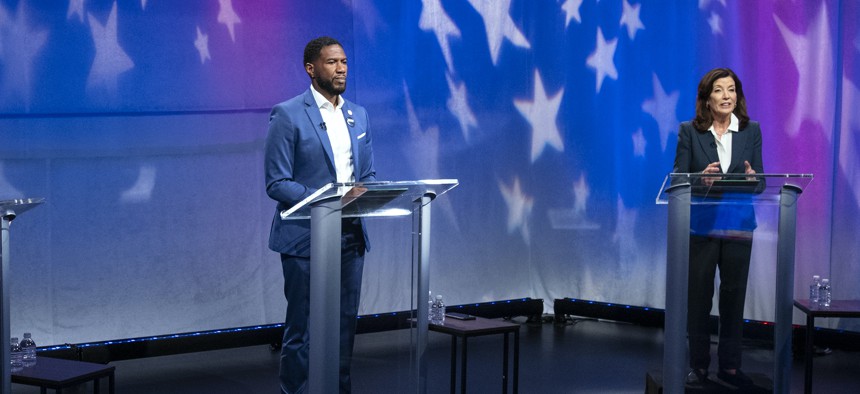News & Politics
New York’s true two-person race for governor
The WFP has replaced Jumaane Williams with Gov. Kathy Hochul on the ballot, removing the last true third party candidate from the November election

The WFP replaced Jumaane Williams with Gov. Kathy Hochul on the ballot without much fanfare. Craig Ruttle-Pool/Getty Images
As promised, the Working Families Party has named Gov. Kathy Hochul and Lt. Gov. Antonio Delgado as its candidates for their respective offices after Jumaane Williams and Ana María Archila lost to them in the June Democratic primary. The development is not unexpected, as the WFP said it would not play spoiler if their original candidates lost, and Hochul said she would accept the party’s line if offered. So it has been for the past several election cycles – albeit with a more cooperative candidate this year.
But the lack of fanfare in itself is noteworthy thanks to a recent change in the law that made the process exponentially easier. And with Williams off the ballot, the race for governor in November will officially have no third party or independent candidates joining Hochul and Rep. Lee Zeldin, a first for the state in recent elections.
In years past, getting a candidate off the ballot presented something of a challenge. The WFP – and any other third party that had nominated a candidate who lost in a major party primary – needed to nominate that candidate for a different office, generally a remote judgeship. In the case of Cynthia Nixon in 2018, who is not a lawyer and could not technically run to be a judge, the WFP placed her on the ballot in her Assembly district. This process was twofold: first, remove the Assembly placeholder by nominating that person to a remote judgeship, then designating Nixon to appear on the Assembly ballot to free up the gubernatorial line for Andrew Cuomo. In short, the process was convoluted and messy.
A new law in the state simplified that process significantly by giving third party candidates the option to decline the designation within a handful of days of losing a major party primary. No placeholders and upstate judicial races needed. Williams and Archila made use of this new law, allowing the WFP to nominate Hochul and Delgado in their stead. Along with ensuring that the two progressive candidates would not split the Democratic vote, having Hochul on their line all but ensures that the WFP will maintain its automatic ballot access by attracting enough votes.
Along with a simplified means to change party nominees, voters will also see an overall simpler ballot than in the past. This year, only Hochul’s and Zeldin’s names will appear, even on other party lines. Hochul will occupy the Democratic and WFP lines, while Zeldin will appear on the Republican, Conservative and (potentially) Independence lines. The last of those required Zeldin to independently petition his way to the line after the party lost its status in 2020, but the state Board of Elections is still reviewing the validity of those petitions. That same year, the Green Party and Libertarian Party also lost their third party status, meaning they could not have party committees and would no longer automatically have a line on the general election ballot. Those two parties have engaged in years-long legal battles in an attempt to gain their status back, arguing against a 2019 law change that made it more difficult for third parties to qualify. They also ran their own candidates rather than cross endorsing the major parties’ candidates, like the WFP and the Conservative Party.
This year, candidates for the Green and Libertarian Parties failed to successfully petition onto the general election ballot. The state Board of Elections rejected the petitions they filed, and in the absence of court intervention, the candidates won’t appear on the ballot. That means voters won’t see perennial Green Party gubernatorial candidate Howie Hawkins, nor Libertarian Larry Sharpe, who ran for election in 2018 as well. Although third party candidates have historically had negligible impacts on the outcome of gubernatorial races in New York, their absence this year truly does make the November election a strictly two-person race.

